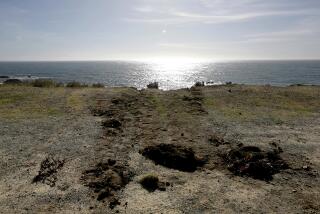BOOK REVIEW: SCIENCE : Studying Children Raised in Wild : FERAL CHILDREN AND CLEVER ANIMALS: Reflections on Human Nature <i> by Douglas Keith Candland</i> ,Oxford, $30, 411 pages
- Share via
We talk to each other, read each other’s words and scan each other’s gestures, all in an ardent effort to understand each other’s minds. Locked in isolation, “each of us knows it is alone in a universe it creates,” reflects Douglas Keith Candland in “Feral Children and Clever Animals.”
Religion and mysticism offer one way out of this isolation. Psychologists and biologists take a different path. This path is the subject of Candland’s provocative discussion of so-called feral (or “wild”) children and intelligent animals.
By studying wild minds, Candland suggests, we can understand how civilized ones reach out and communicate with others. Candland offers a series of fascinating, heart-rending tales of children who shared the misfortune of arriving in human society naked and without language at an age when they were no longer able to compensate for their lost childhoods.
Laura Bridgman, for instance, was born in Hanover, N.H. in 1829. A clever child who at two had “mastered the difference between A and B,” Laura fell ill before her third birthday and recovered, five months later, without the sense of sight, hearing, taste or smell.
At home, Laura learned by touch to knit and to love her family, but she could not communicate with them. Then, eight years into her isolation, a remarkable “Dr. Howe” took her into his institution and invented an early form of Braille, which enabled her to communicate with others.
Laura’s life was successful in contrast to the lives of the physically healthy but psychologically damaged children who appear to have been abandoned and raised by animals. There is Wild Peter, found in the woods outside of Hameln, Germany, in 1725; Victor, the famous wolf-boy of the French town of Aveyron, who entered history in 1800; and Kamala and Amama, a pair of small girls discovered inside a wolf’s lair near Midnapore, India, in 1920.
Their tragedies seem to prove that much of the way human beings understand the outside world comes from living with compassionate adults through crucial stages of development.
With a few exceptions, studies of the minds of feral children have been displaced in our time by studies of the minds of our almost human cousins, chimpanzees and gorillas. This is partly because we need to perform controlled scientific experiments for which it is generally considered immoral to use human beings, but still all right to use animals whose mental and psychological make-up seem so like our own.
Candland, a psychologist at Bucknell University, argues that each study of these feral children has greatly influenced the development of psychology. Whether the subject is child or beast, Candland points out that “the Cemetery of Misinformation is replete with experiments and experimenters whose arrogance has led them to believe that they are in charge.” There is a fallacy in believing that Washoe the chimpanzee, for example, could have learned sign language without influencing the judgment of her human teachers.
There is no doubt that the animal studies of the past 30 years have blurred the lines between species. We can no longer argue that only humans use tools or language to communicate with each other. What remains unique to humanity, Candland concludes, is our determination to reflect on the nature of thought. One clear demonstration of this, Candland writes, is our determined pursuit of ways to “decode the reflections from the minds of feral children and clever animals.”
More to Read
Sign up for our Book Club newsletter
Get the latest news, events and more from the Los Angeles Times Book Club, and help us get L.A. reading and talking.
You may occasionally receive promotional content from the Los Angeles Times.







